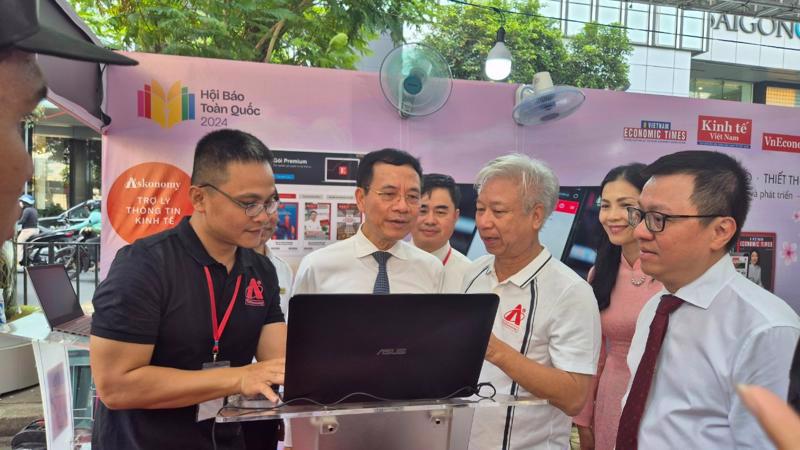The AI chatbot Askonomy, dubbed the "Economic Information Assistant," unveiled its latest iteration at the 2024 National Press Conference. Developed by VnEconomy/Vietnam Economic Times in collaboration with partner Actable AI, Askonomy aims to address pivotal concerns surrounding the security and accuracy of data sources, paramount considerations for organizations venturing into AI chatbots. Mr. Tran Hoai Van, Actable AI's COO and Askonomy's development partner, elucidated on how Askonomy tackles these challenges in a dialogue with VnEconomy/Vietnam Economic Times.
The AI chatbot market in Vietnam is on par with global standards
What is your assessment of the global and vietnamese AI chatbot market?
It is worth noting that chatbots have been present since the early days of computing from a technological standpoint, aiding users in interaction and assistance. However, there has been a notable shift in the perception of chatbots in recent times. They are now viewed as tools utilized by users to engage in text-based conversations for information retrieval. Moreover, a second-generation of chatbots is emerging, characterized as intelligent virtual assistants.
Consequently, there is an ongoing enhancement in the flexibility of interaction between chatbots and humans. While still somewhat limited, contemporary chatbots have become increasingly human-like. From a technical and professional perspective, there has been a progression from traditional models reliant on scripts and rigid communication to large language models capable of more flexible word and image selection. Presently, chatbots, often referred to as virtual assistants, are equipped with large language models (LLMs) capable of processing various languages.
Assessing the market perspective, let's consider the supply and demand dynamics for chatbots. Initially, upon their introduction, chatbots garnered significant interest and extensive use. However, over time, users discovered numerous limitations that hindered their utility, leading to a decline in usage and sometimes even disregard for chatbots.
Nevertheless, the emergence of ChatGPT has introduced distinctiveness and unexpected developments. With this expansive language model, there has been a resurgence in the demand for chatbots, manifesting as an immensely appealing trend. It's palpable that where there is demand, there will be a corresponding supply, and where demand is high, the supply will be plentiful and diverse.
From both domestic and international market standpoints, there appear to be striking similarities. Despite a slight lag in Vietnam compared to the global market, the internet's ubiquity has facilitated the seamless adoption of products and technologies across countries. This phenomenon is particularly evident in Vietnam, where the rapid pace of internet development renders the penetration of products and technologies relatively straightforward.
In your perspective, do you believe Vietnam should prioritize the development of chatbots tailored for large-scale user groups, or should it concentrate solely on specialized products?
The decision regarding the scale of chatbot development to pursue should ideally be determined by market forces. From my viewpoint, contemporary chatbots have the potential to serve various aspects of life, with some targeting niche markets while others cater to broader societal needs. These can be categorized into two models, labeled as "2C" and "2B," both of which present development opportunities in Vietnam.
The "2B" model focuses on specialized industries and niches, whereas the "2C" model aims for widespread adoption among the general populace. However, it's important to recognize that each region and province may possess unique characteristics, necessitating different approaches to data processing and information management. Consequently, the investment and development prospects for both models in Vietnam remain substantial, accommodating both niche and mass markets.

Askonomy ensures security and accurate results thanks to reliable data sources.
As you mentioned, Vietnamese businesses have many opportunities to participate in the chatbot market. However, what challenges will they face in chatbot business?
In terms of supply, I anticipate a proliferation of sources, as numerous businesses are poised to enter the market due to the current surge in demand. However, throughout the development phase, I've identified two primary constraints. The first pertains to data, while the second relates to investment. For a chatbot to evolve into a user-friendly platform capable of delivering precise responses and valuable insights, it necessitates access to accurate and current data tailored to meet output requirements effectively.
Concerning data, the current landscape in Vietnam presents a significant challenge for businesses and the nation as a whole. Data fragmentation and lack of cleanliness pose significant obstacles to chatbot development.
The second obstacle lies in the expenses associated with investing in and maintaining an efficient language model. Moreover, costs related to infrastructure, personnel, construction, maintenance, and training could prove burdensome for organizations, businesses, and governmental entities alike. Even on a global scale, the deployment of large chatbot models requires substantial financial investment, amounting to billions of dollars.
Nevertheless, cost concerns may not be overly significant. While developing a language model akin to ChatGPT and directly competing with it demands substantial financial resources, businesses can alleviate cost pressures by prioritizing domestic expansion and addressing local needs, particularly in Vietnamese, progressively and incrementally.
Furthermore, the investment capital market boasts global accessibility. Therefore, it is imperative for businesses to cultivate an efficient business model, meet market demands, and demonstrate the capacity to penetrate new markets. By doing so, the significance of investment capital will be mitigated.
What is your opinion on the security issues of AI chatbots?
While I'm not a security expert, it's apparent that in the realm of artificial intelligence, security represents a novel form of knowledge, unprecedented in the world. This implies that beyond the notion of AI solely as an IT construct, it necessitates traditional security protocols. AI is intricately linked to input data, the training process, and the subsequent model refinement.
Throughout this process, numerous security vulnerabilities may emerge, resulting in inaccuracies in the AI's outputs. Hackers could exploit these vulnerabilities, compromising the AI's accuracy. This poses a specific security risk for AI virtual assistants, potentially violating ethical standards and legal regulations.
Moreover, a critical facet of AI pertains to the input data of the model, typically comprising text segments or user requests in chat or voice format. The inherent complexity of language in this input renders the connection between the data system and the model susceptible to security breaches and misinformation. Addressing this challenge demands profound expertise in AI security to ensure the accurate and secure handling of queries and concepts fed into the AI model. Failure to execute this process correctly may lead to distorted results and inaccuracies in the AI's responses.
As the COO of Actable AI, the partner unit responsible for developing Askonomy, would you kindly elaborate on Askonomy's security solutions for our readers?
Throughout the research and development phases of Askonomy, we consistently place a strong emphasis on security, particularly by prioritizing the utilization of standardized and verified data sources from the project's inception. Askonomy's data is sourced from VnEconomy's exclusive data repository, as well as from legitimate data sources authorized for use by governmental bodies. With access to such reliable data sources, we firmly believe in the robustness and dependability of Askonomy's output.
Furthermore, in addition to acquiring accurate and pristine data from reputable sources, we place great importance on regular data updates. This practice ensures that Askonomy's findings consistently align with the stringent standards of the discerning market segment we serve, comprising individuals well-versed in economics and those seeking comprehensive economic insights, such as experts and entrepreneurs. These user cohorts possess advanced skills and knowledge in analyzing economic data and figures, thereby necessitating a high level of accuracy and completeness in the data sources and resultant information provided by Askonomy. Consequently, we strive to continuously enhance the accuracy and quality of Askonomy's data to cater to their evolving needs, underscoring one of Askonomy's core strengths.
A wholenew way of reading newspapers
Hence, it is evident that Askonomy has effectively tackled a substantial challenge concerning the security and accuracy of information, an issue that has historically plagued AI chatbots. This achievement can be attributed to the utilization of reliable data sources and the implementation of frequent updates. Positioned as an "economic information assistant," Askonomy caters to a specialized user base. From a business standpoint, how does Actable AI intend to strategize and entice potential customers to utilize Askonomy?
In addition to the previously mentioned strengths of Askonomy, I'd like to offer another perspective, highlighting our groundbreaking strides in the media market. Historically, readers primarily consumed news for information gathering purposes. However, with Askonomy, they can engage in natural conversations, exchange ideas, and access tailored information seamlessly. This transformative approach facilitates easier and more efficient information retrieval.
From my viewpoint, we are pioneering a new paradigm in journalism, representing a significant breakthrough in the media industry. This innovation serves as compelling and engaging content with remarkable potential for virality. The transition from traditional print newspapers to online news and now to Askonomy's interactive format holds particular appeal for younger generations keen on staying abreast of market trends. Effectively incorporating this product into our communication strategy promises to yield an exceptionally attractive and effective market approach.
Furthermore, collaborating with esteemed media outlets like VnEconomy presents a unique opportunity. Leveraging VnEconomy's sizable base of loyal readers and introducing them to Askonomy will undoubtedly expand our reach. I am confident that VnEconomy, along with our development team, will devise precise and expedient customer outreach strategies for Askonomy and VnEconomy in this new phase. Our shared objective is to foster loyalty, drive expansion, and uphold quality, aspirations shared by many other media organizations.
So, I comprehend that utilizing Askonomy represents a novel approach to newspaper consumption, fostering a more proactive reading experience for users. Unlike traditional mediums such as print newspapers, online news platforms, or mobile apps, Askonomy empowers readers to curate their content and search for information tailored to their individual preferences. Moreover, users have the option to explore related articles and delve into specific details, fostering an active engagement with news content. In essence, Askonomy enables readers to actively participate in their news consumption, offering a flexible and personalized reading experience. Does that align with your understanding?
Indeed, addressing user needs is paramount, particularly in today's digital landscape where rapid and convenient access to information is imperative. However, the prevalence of information overload often complicates the search process, leading individuals to become overwhelmed when browsing online or on social media platforms.
Enter Askonomy—a solution that transcends traditional article reading by offering a streamlined chatting experience. Unlike conventional search engines that necessitate sifting through numerous articles, Askonomy delivers prompt and precise synthesized information via chat interactions. Looking ahead, Askonomy plans to enhance the conversational experience by introducing voice capabilities, thereby facilitating even quicker and more accurate information retrieval. I am confident that this evolution will herald an exciting new chapter in user engagement.









 Google translate
Google translate